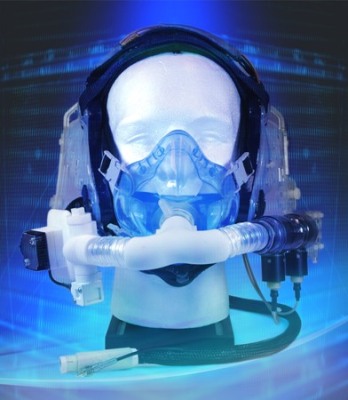Technology originally designed by NASA Glenn scientists to monitor the health of astronauts is finding new applications here on Earth that could significantly impact the safety of pilots and the rehabilitation of cardio-pulmonary patients.
 The headgear, shown here, features NASA developed sensors that help monitor healthcare patients for a variety of metabolic functions. Image credit: NASA.
The headgear, shown here, features NASA developed sensors that help monitor healthcare patients for a variety of metabolic functions. Image credit: NASA.
NASA engineer Dan Dietrich and a team of scientists at Glenn developed the Portable Unit for Metabolic Analysis (PUMA) to monitor the oxygen consumption and carbon dioxide production rates of astronauts exercising during long missions. The portable unit was designed to give the crew the ability to move around the spacecraft without being tethered to a large immovable unit.
PUMA measures six components to evaluate metabolic function: oxygen and carbon dioxide partial pressure, volume flow rate, heart rate, and gas pressure and temperature. From those measurements, PUMA can compute the oxygen uptake, carbon dioxide output and minute ventilation (average expired gas flow rate). A small, embedded computer takes readings of each sensor and relays the data wirelessly to a remote computer via Bluetooth.
"We keep refining the size and efficiency of PUMA," says Dietrich. "The latest version weighs less than two pounds and transmits data wirelessly in real time. And now, through commercial agreements, components of PUMA are being used in a wide variety of industries."
Orbital Research, Inc., which signed a Space Act Agreement with NASA in 2009, is currently testing hardware that uses technology to monitor oxygen levels of Air Force F-22 pilots. A series of accidents involving pilots suffering from hypoxia, or a lack of oxygen, led the military and the manufacturer to approach Orbital for hardware capable of answering why those events occurred.
Today, the first prototype system, featuring a fleet of sensors in the pilot's oxygen mask, is flying with the pilots and offers warning signals if the sensors detect the onset of hypoxia before symptoms set in. The goal is to give the pilots a warning so they can take countermeasures to start supplemental oxygen or lower their altitude. After 40 flights, data is being analyzed to further understand the problem.
"We have expanded the PUMA technology developed at NASA to create new devices for specific work with the warfighter," says Aaron Rood, medical products manager at Orbital. The company just finished the first phase of a project with the Navy SEALs to develop a sensor suite in diving gear that provides biometric data to both the diver and support staff in the boat during actual combat missions. Rood expects development to continue on the Navy gear.
Meanwhile, the healthcare industry is investing in PUMA technology for the purpose of monitoring patients. "Summa Health System has just signed an agreement with NASA to use our headgear to assess patients with COPD (Chronic obstructive pulmonary disease)," explains Dietrich. "PUMA will help them make physiological measurements to assess rehabilitation efforts."
According to Summa's Dr. Matthew Krauza and Women's Health Research Director Michele McCarroll, PUMA will serve as a valuable clinical tool to provide information affecting treatment and outcomes in the pulmonary disease population.
In addition, the Cleveland Clinic wants to use PUMA to measure the metabolic functions of pulmonary patients. The idea is to have a portable, easy to use unit that takes measurements during a six-minute walk test in the hospital.
University Hospitals physicians in Cleveland think the technology might work to monitor epileptic patients during severe episodes, which would lead to a better understanding of the physiological effects of seizures.
"The healthcare industry is attracted to PUMA features, which include the units being wearable, versatile, small, low-power, minimally invasive and able to address the monitoring requirements of multiple scenarios," explains Dietrich.
The possible applications for using PUMA technology for human health continue to grow. In the future Dietrich believes it can be used to determine the caloric requirements of daily living activities to develop nutrition and weight loss programs; to assess the nutritional needs of critical care patients; to determine the impact of certain foods on metabolic rate; and to quantify the field training of athletes to design effective training programs.